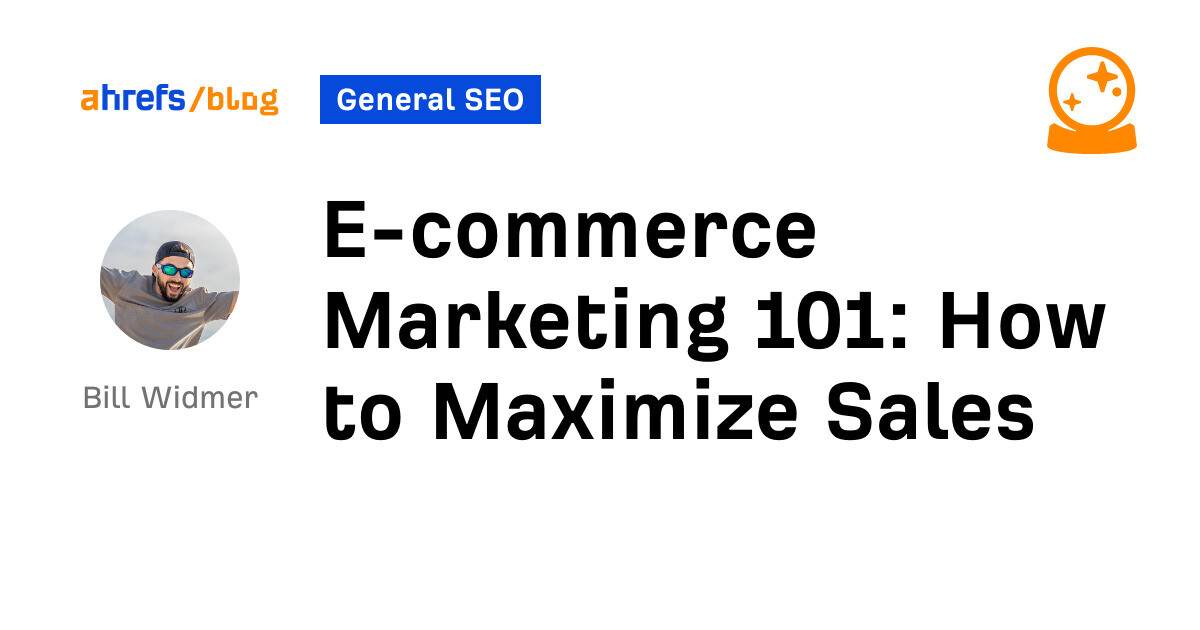Marketing is one of the most important skills to learn as an e-commerce store owner. By learning marketing, you’ll always have a steady stream of new customers.
Plus, knowing the basics of marketing can get you ahead of the competition, and it’s valuable to have a base understanding if you ever hire marketing roles for your company.
In this guide, I share the five main marketing channels and how to use them, plus a few marketing tips to help you earn more and spend less.
There are five main channels you can use to promote your products. They are:
- Search engines
- Social media sites
- Email inboxes
- Display ads
- Brand affiliates
Let’s talk about how you can use each of these channels in your e-commerce marketing plan.
1. Search engine marketing (SEM)
Search engine marketing covers both organic and paid traffic from search engines like Google.
Both are important. Take Solo Stove, for example. Its online store gets over 300,000 organic visits from Google every month—plus an additional ~28,000 monthly visits from paid ads:
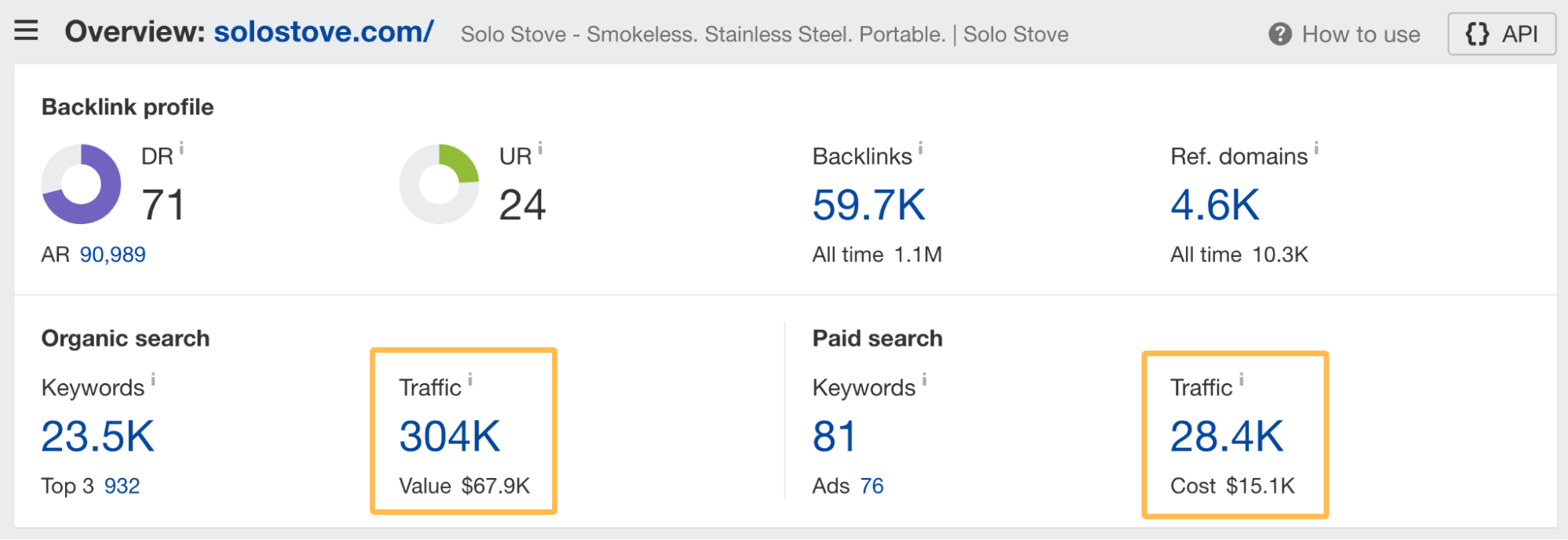
Search engine optimization (SEO)
In order to show up organically on the first page of Google’s search results, you need to learn and implement search engine optimization practices on your website.
This includes things like:
- Figuring out what keywords people are searching for to find your products.
- Aligning with the search intent of the query.
- Getting other websites to link to your website (aka backlinks).
- And more.
I’ll discuss these steps in more detail in the “tips” section below. For now, if you want to learn more, check out our complete guide to e-commerce SEO.
Paid search ads
You can pay to “skip the line” and show up at the top of Google’s search results. This is called pay-per-click (PPC) advertising, and it’s a great complement to your SEO efforts. PPC ads are a quick and easy (albeit sometimes expensive) way to get in front of your target audience.
Here’s a chart explaining why you should utilize both PPC and SEO:

What does this look like? You’ve probably seen ads like these, annotated with the word “Sponsored” next to them:
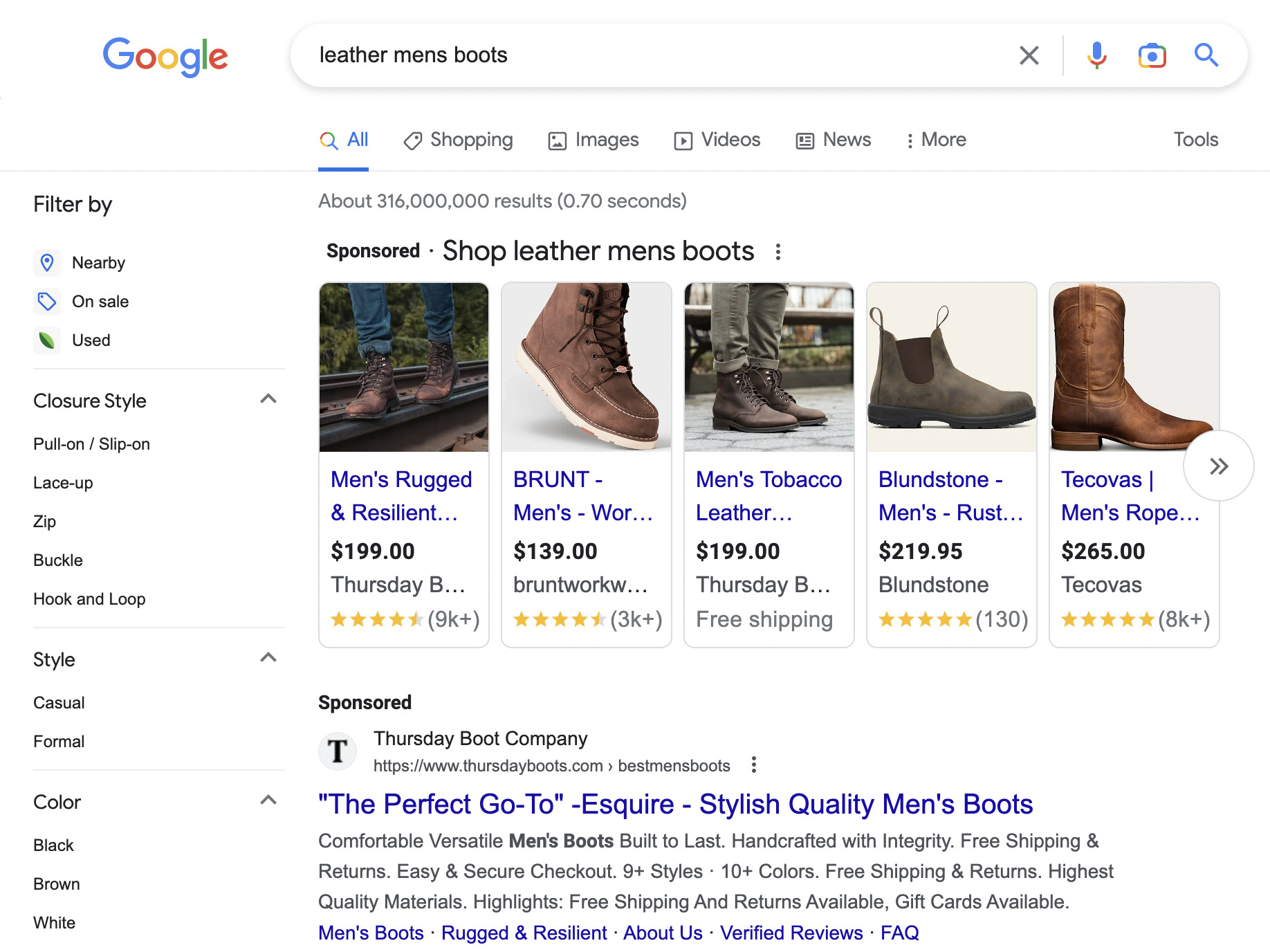
You can run Google Ads by creating an account, choosing the page you want to send visitors to, writing up various headlines and description ad copy, and selecting keywords to be displayed for.
But there’s quite a bit more to it than that—it takes time and money to learn what works. Check out our guide to Google Ads basics to get started.
2. Social media marketing
Probably the most obvious place to market your e-commerce store is on the many social media apps.
Again, with Solo Stove as an example—it uses both organic and paid social media marketing and has been able to gain over half a million TikTok followers, 347,000 Instagram followers, and almost 300,000 Facebook followers.

Let’s take a look at how you can do the same:
Organic social media marketing
Growing an organic following on social media is a great way to get your brand and products in front of people without spending a ton of money. However, it’s also a lot of work—especially if you plan on growing multiple channels.
If you’re not sure which channel(s) to use, a good starting point is SparkToro. You can type in a product keyword like “mens boots,” and it’ll show you social stats of relevant accounts:
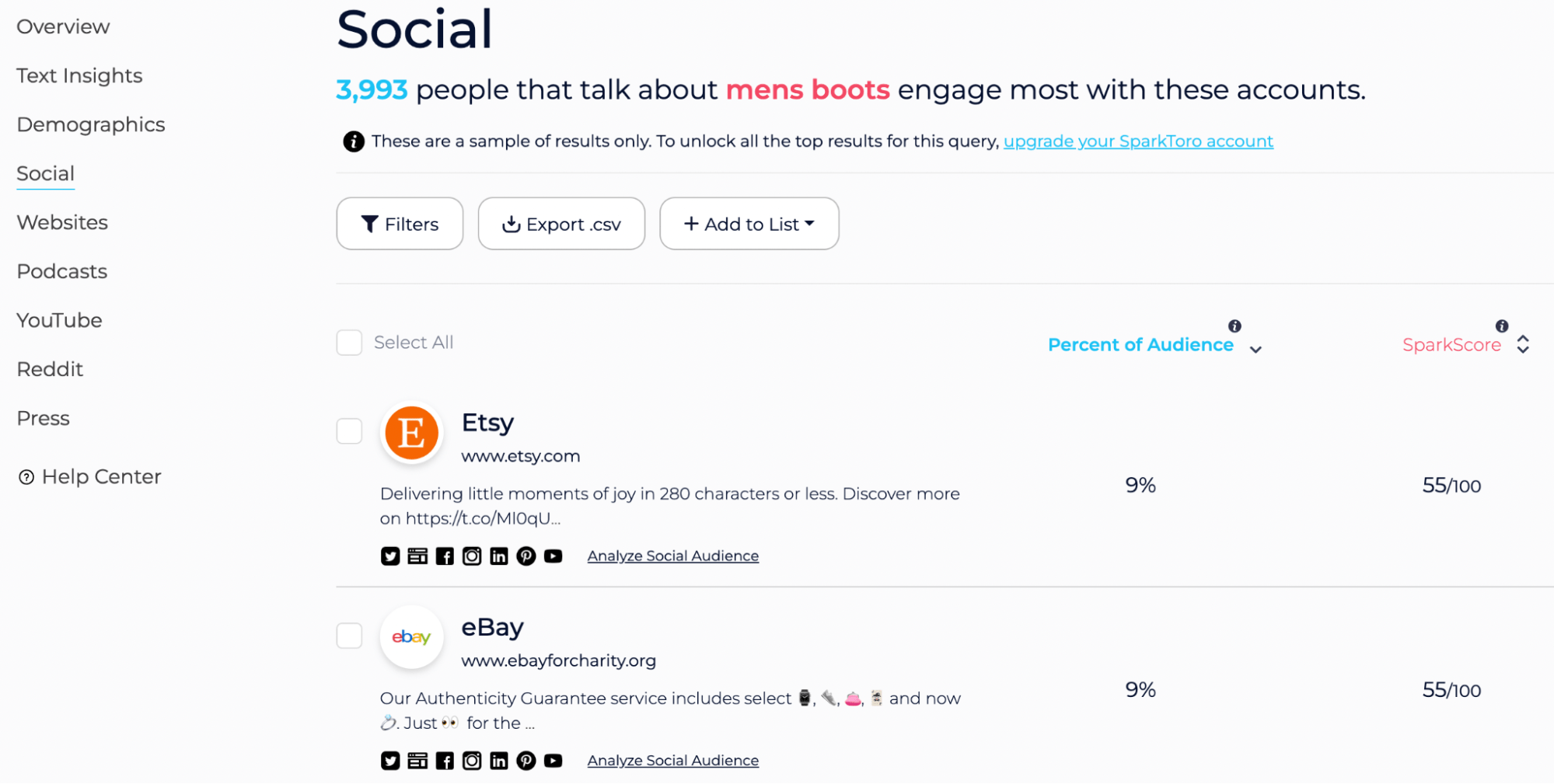
From here, if you hover over the social media icons, you can see the individual channel statistics. This tells you which channels brands have the most followers on, which can be a hint on which channels are most effective for them.

Use this data to decide which channels you should invest your time in first. From there, check out this list of resources to learn more about how to grow your accounts.
Paid social media advertising
The other side of the coin is social media PPC ads. You can use ads to drive immediate sales—but at a cost. There’s a steep learning curve to maximizing sales while minimizing ad costs.
That said, one of the easiest ways to run a successful social media ad is through retargeting customers who abandon carts. This works by putting a browser cookie on a visitor who adds an item to their cart but doesn’t check out, then using that cookie to show them ads on social media of the item they left in their cart.
Again, Solo Stove does this well. I added this heat deflector to my cart…

… then almost immediately saw this ad on my Facebook feed after leaving its site without buying:

There’s a lot more you can do with these ads, though. Check out Mayple’s guide to social media advertising to learn more.
3. Email marketing
Email newsletters are typically one of the highest-converting traffic sources for e-commerce stores. This is because your email list, if done well, will be full of people who know who you are and have an active interest in your brand. That said, you need traffic to grow an email list, so it doesn’t make a good stand-alone marketing channel.
There are many ways to grow an email list, including:
- Email opt-in forms on your site offering a discount or free information.
- Collecting your customer’s emails when they make a purchase (with their permission, of course).
- Running a giveaway for your products.
Once you have an email list, you can send them product updates, content from your blog, clearance sales, etc.
Here’s an example from clothing brand Off The Grid, which uses its newsletter to give tips on how to get the most out of its clothes:

Just make sure you keep your list engaged by deleting inactive subscribers every three to six months and avoid sending too many emails. Your list is one of your biggest assets, so take care of it.
4. Display ads
Have you ever been bombarded by display ads on every website you visit after looking at an online store but leaving without buying anything?

This is because the online store you visited placed a cookie in your browser that allowed it to “retarget” you with display ads across any websites that run these retargeting ads. What I already showed in the “social media ads” section above was a retargeting ad too.
It’s been found that it takes anywhere from 28–62 (or more) “touchpoints” to make a sale.
A “touchpoint” is any time a potential customer is shown a brand, either through an ad or by visiting your website or social media channel. Every time they see your brand or product, that’s one touchpoint.
That’s what makes these retargeting ads so effective. You can get multiple touchpoints of your product at a relatively low price compared to traditional PPC ads.
The catch is that you can only show retargeting ads to people who have either visited your website and allowed the cookie in their browser settings, or to people in your email list.
HubSpot has an excellent beginner’s guide to retargeting if you want to learn more.
You can also run general display ads, which are suitable for making people aware of your brand and products. You can use them to get people to your site, then run retargeting ads to those people who visited your initial ad but didn’t purchase.
For example, Advance Auto Parts paid to show me these display ads across various blogs even though I haven’t visited its site before:

Check out Google Display Ads if that’s something you’re interested in.
5. Affiliate marketing
Affiliate marketing is where someone promotes your product or service and makes a commission any time they send you a sale.
This typically works by giving your affiliate a unique ID that they include in their URL when they link to your website. It might look like this:
https://www.yourdomain.com/your-product?ref=UniqueAffiliateID
When a customer makes a sale through the URL with the unique affiliate ID attached, your affiliate program will attribute that sale to that particular affiliate so you can pay them their percent of the income.
For example, Solo Stove has an affiliate program, and I used to promote it in my articles and videos, like this blog post and YouTube video review:

To learn more about setting up an affiliate program for your e-commerce store, see this guide.
Now that you know where to promote your products, here are a few tips to help you maximize your sales and minimize your marketing costs:
1. Don’t compete solely on price
Above all, never get into a price war. You will never be able to compete with giant brands on price. They can afford to lose money until you’re long out of business.
Instead, compete on things like quality, customer service, experience, and value.
Make sure the entire experience of finding your brand and buying from you is seamless and easy. And use your marketing to educate and entertain, not just to promote your product. If you offer people something of value first, they will be more likely to buy, even at a higher price point.
For example, Squatty Potty both informs and entertains in what is arguably one of the best ads ever made:
Or, back to Solo Stove, it makes videos that teach you the best way to use its products:
2. Don’t offer big discounts
Offering discounts may be an easy way to make a quick buck. But in doing so, you may be shooting yourself in the foot. By offering frequent discounts, people may come to expect your discounts and won’t buy your products at full price because they know discounts are coming.
3. Begin with keyword research
Search engines can be a lucrative source of free marketing if you’re able to rank highly on them. But SEO can take years—especially for a beginner.
That’s why it’s best to do some keyword research to figure out what your customers are searching for so you can start optimizing your site right away. (You’ll thank me in two years.)
You can do this with Ahrefs’ free keyword generator tool. Type in a broad keyword that describes your products, and the tool will spit out keyword ideas with some basic data:

Keep in mind that you’ll want to find different keywords for different purposes.
For example, “brown leather boots” may be a good keyword for your category page, while your product pages may be better served with more specific keywords like “brown leather ugg boots” or “womens brown leather knee high boots.”
Basically, use broad keywords for category pages and specific keywords for product pages. Again, refer to our e-commerce SEO guide to learn more.
4. Optimize your website for search and conversions
Continuing from the last tip, you should take the keyword research you did and optimize your category and product pages for their best keywords.
This is called on-page SEO, and it involves:
- Talking about your target keyword in your title, URL, and within the page itself.
- Writing a compelling title tag and description to make your result stand out on the SERPs.
- Optimizing your images to load fast and have descriptive filenames and alt text.
- Including internal links between your pages to make them easy to find.
There’s a bit more that goes into it, so read our on-page SEO guide to learn more.
Beyond SEO, you should also optimize your website for conversions. After all, you don’t want to spend all this time and money on marketing only to lose sales, right?
Conversion rate optimization (CRO) includes things like using high-quality images, effective copywriting, and clean website design with minimal distractions. I highly recommend going through Shopify’s CRO guide.
5. Start a blog
Having a great product and effective ads can only take you so far. If you want to utilize organic marketing channels like social media, search engines, and newsletters, you need to offer more than just advertisements for your products.
That’s where content comes in.
Photos, videos, and blog posts give you the ability to capture customers at different stages in the marketing funnel whom you otherwise wouldn’t have sold to.
Here’s what this may look like and what people may search for at each stage:

Let’s say you own a shoe store. A potential customer has a problem; they need a good pair of waterproof shoes that are functional but also look good. So they do a Google search for “stylish mens waterproof shoes” (the “service or product” stage).
The results aren’t shoe stores. They’re all blogs that talk about shoes:

It’s possible for you to write a blog post of your own with the goal of ranking well for that keyword and promoting your own shoes. You can also use that article as content to add to your email newsletter and social media feeds.
Pro Tip
Expand this idea for other issues potential customers may have, like learning different ways to tie shoes or ideas for outfits that can go with your shoes. You’re only limited by your creativity.
Check out my guide to e-commerce blogging to learn more.
6. Create video content
Video content is becoming more and more important. If you want to do well on TikTok, Instagram, YouTube, and even Facebook, you need to make videos. Plus, many of the SERPs now contain video results in addition to blog pages.
For example, we manage to rank for the keyword “learn seo” with both a blog post and a YouTube video:
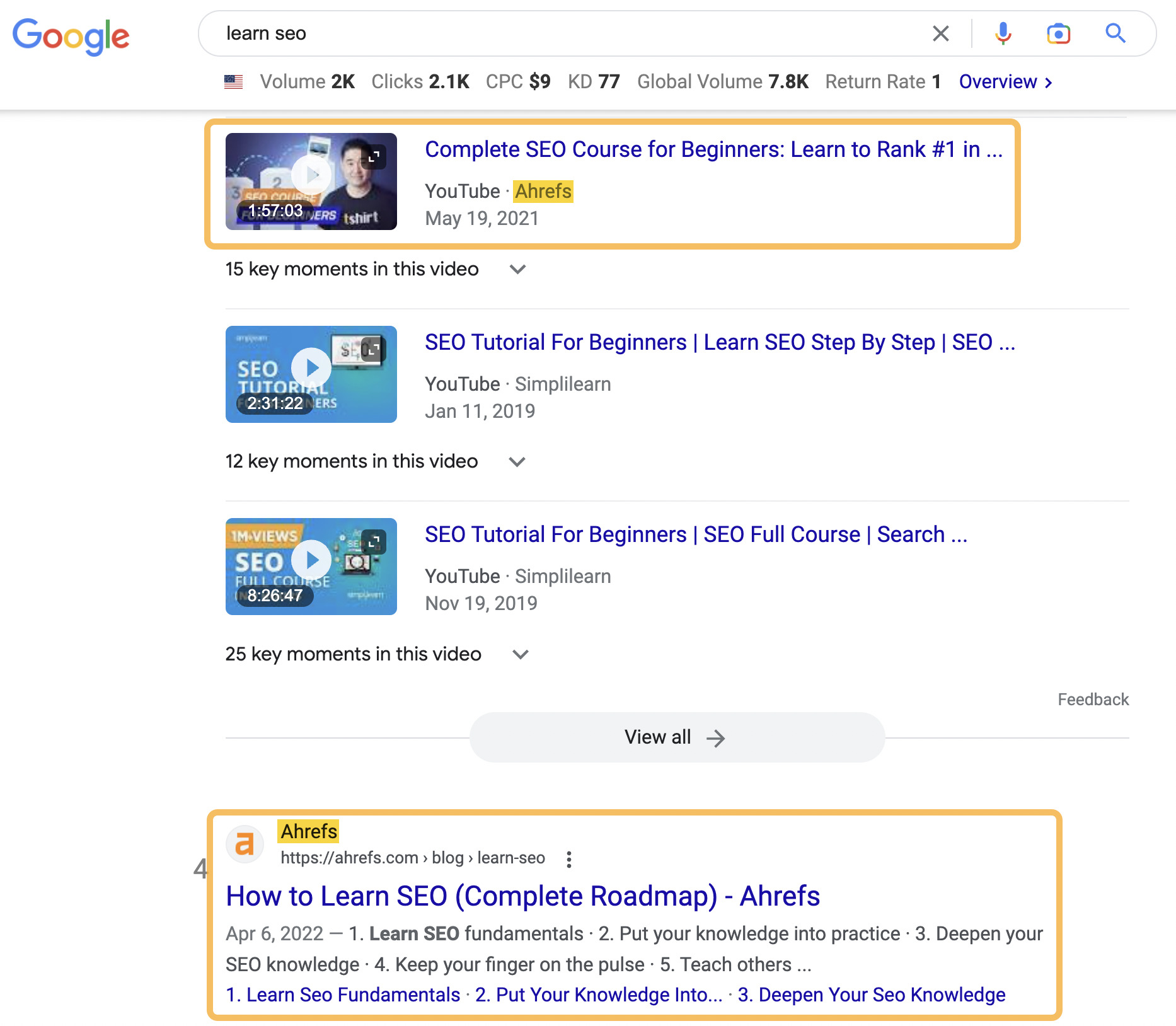
We wrote a full guide to video SEO if you want to learn how we did it.
But what kind of videos should you create?
It depends on your audience, the platform, and your product. In general, shorter videos do better than long ones, like this five-second TikTok by Guess that got over 800,000 views:
Of course, there are a lot of ways to utilize video in your marketing plan, and there’s plenty of space for longer videos. Check out our guide to video marketing to learn more.
7. Make standard operating procedures
Many of your marketing tasks will be repeatable. Things like outlining your content, sharing your posts, and even running ads can all be standardized to make things quicker and easier.
This is why you should create standard operating procedures for these tasks. A standard operating procedure (SOP) is a document that outlines exactly how to do a task step by step—often with screenshots or videos—that allows you to hand off the task to a virtual assistant to free up your time and streamline the process.
For example, we have a guide to creating SEO SOPs. But you can make an SOP for any repeatable task, such as:
- Creating blog or product images.
- Adding new products to your newsletter and social media feeds.
- And so much more.
Here’s an example of a step in our SOP for creating content at Ahrefs:
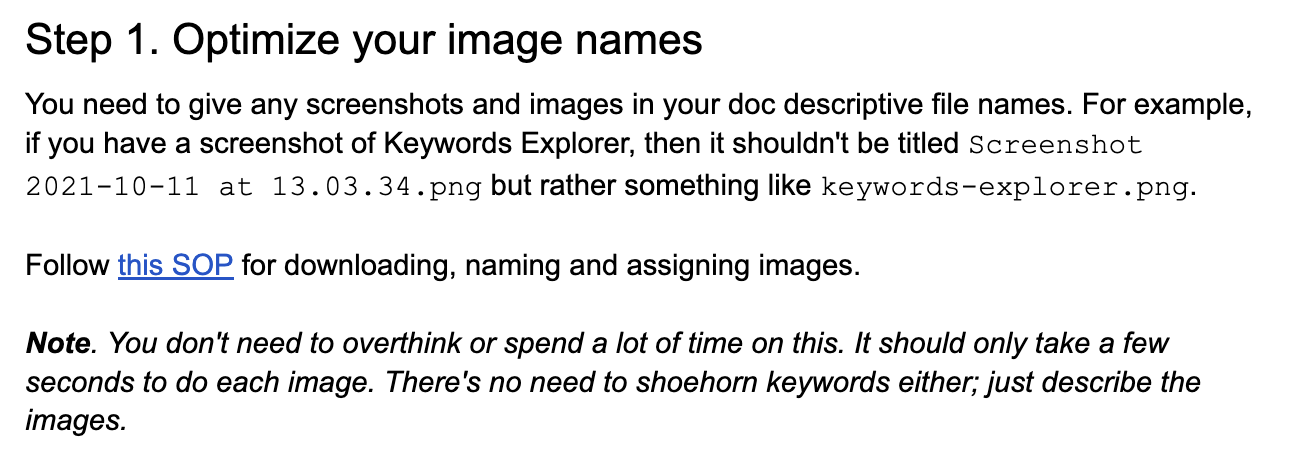
Creating an SOP is easy. Just create a Google Doc and use headings to organize your task into steps and add screenshots or even videos to show the process. The clearer and more concise you can be, the better.
Final thoughts
Learning e-commerce marketing is a surefire way to make a lot more money from your online store. There’s a lot to learn, so take it one thing at a time.
Eventually, you should aim to hire a VA or marketing team to help with these tasks so you can focus on other areas of your business. Having a basic understanding of how they’re done will help you make good hiring decisions.
